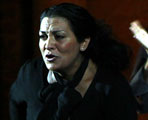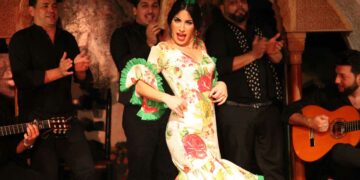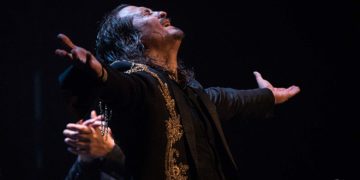17 Bienal de Sevilla
Thursday, September 6th, 2012. 10:00pm. Real Alcázar de Sevilla
Special 17th Bienal de Flamenco de Sevilla – All the information
Text: Estela Zatania
Photos: La Bienal
Bollywood in Seville
La Farruca Compañía Flamenca. Dance: Rosario Montoya “La Farruca”, Manuel Fernández Montoya “El Carpeta”. Cante: Pedro Heredia “El Granaíno”, Mara Rey. Guitar: Juan Requena. Violin: Bernardo Parrilla.
Anuj Arjun Mishra Kathak Company. Dancers: Smriti Mishra, Kantiki Mishra, Anuj Mishra. Musicians: Vikas Mishra (tabla), Hridya Desai (voice and sarod). Dharamnath Misra (voice and harmonium).
“Las Huellas”, ‘footprints’, is the title given to the series of shows which includes the one we saw last night at the Alcázar within the program of the Bienal de Flamenco de Sevilla.
Being a show that includes flamenco and Indian music and dance, not always independently of each other, the term “footprints” seems to suggest we know the history of flamenco when in fact very few historians agree on this topic, and theories about a Caribbean or South American origin are now fashionable, while there are also those who defend the African continent as the birthplace of flamenco.
My knowledge of Indian music borders on non-existent, so any commentary regarding it must be accepted as pure opinion, unhindered by any sort of actual information. This isn’t the first time, nor will it be the last, that an effort has been made to bring flamenco together with a disparate culture in order to “demonstrate” common roots. But as tends to happen, last night achieved quite the opposite. The common gene pool does seem unquestionable if we are to believe our own eyes: any of the Hindi artists could dress a little differently and pass for gypsy. And vice versa. Nevertheless, neither the music, nor the meter, nor the movements, much less the emotional landscape bear any credible resemblance to flamenco. The dancers stomp their feet on the floor and move their arms you say? All humans have arms and legs, a head and torso, it’s what we’ve got to work with, and to attribute any affinity to such things is questionable at best.
Academic considerations aside, because art is not to be explained, but rather felt, the entire production has little coherence and quite a few weak points. With regard to the part carried by the Indians, you get the feeling of having been sold a cheesy cabaret number designed for tourists. The main dancer takes the microphone time and again, like a night-club host, to point out (in English) details of little interest and even urge audience participation – completely out of place given the nature of this event and venue. Further kitsch was provided by a sort of narrator who used a falsely hoarse voice which could barely be understood.
And moving right along to the flamenco… No matter how hard the author of the script tried to put la Farruca, Carpeta and their musicians on an equal plane with the Indians, the outstanding competence, seriousness and command of the flamenco outshined all the rest. Lesser artists might have been diminished or intimidated by the exotic performers, but the Farrucos have a devastatingly strong sense of artistic identity that illuminates each and every moment.
The reduced backup was more than sufficient. The cante was managed by el Granaíno whose way of singing is the ideal complement for the tensely emotional style these artists cultivate. Mara Rey, always competent and very flamenco struggled with a hoarse voice but got the job done. And Juan Requena, amazing, playing alone he managed to multiply himself and gave these people all the energy they needed.
La Farruca was magnificent in siguiriya and soleá…any further comment is superfluous. El Carpeta continues to surprise us, not only because of his maturity and strength, but because he’s managing to develop a personality of his own with the well-defined family line. Mother and son, two voices and a guitar, flamenco served in all its glory. Zero dialogue with the exotica that made up the rest of the show, and once again we see that straight-up flamenco is self-sufficient, and the more contrivances added, the more credibility is sacrificed.
Descubre más desde Revista DeFlamenco.com
Suscríbete y recibe las últimas entradas en tu correo electrónico.





























